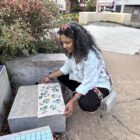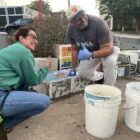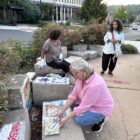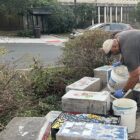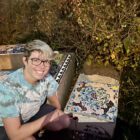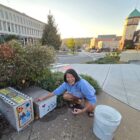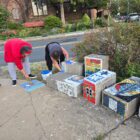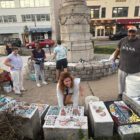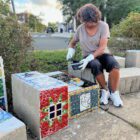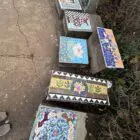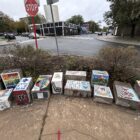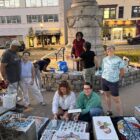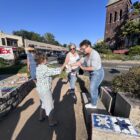Just as a mosaic is best seen when all the individual pieces come together create a bigger picture, individuals are stronger when they come together in community, so it made sense that the Community Coalition on Race chose mosaics as one of its Integration Through the Arts projects.
Over the course of two summers, the mosaics Integrated Art Circle has involved a few dozen community members from diverse backgrounds who came together in workshops led by local artist Sandra Charlap and installed their mosaics this fall on the blocks around the flag pole in downtown South Orange.
“I love this art form and being able to share it with people and have them learn it and tap into their culture and creativity and come together in community is what it’s all about,” said Charlap, who recently had one of her own mosaic pieces featured in a group show at the Newark Art Museum as part of the Newark Arts Festival. “The group came together in great harmony, and the results are outstanding. We are looking so full at this point that it seems that next year will probably be the fulfillment of this project.”
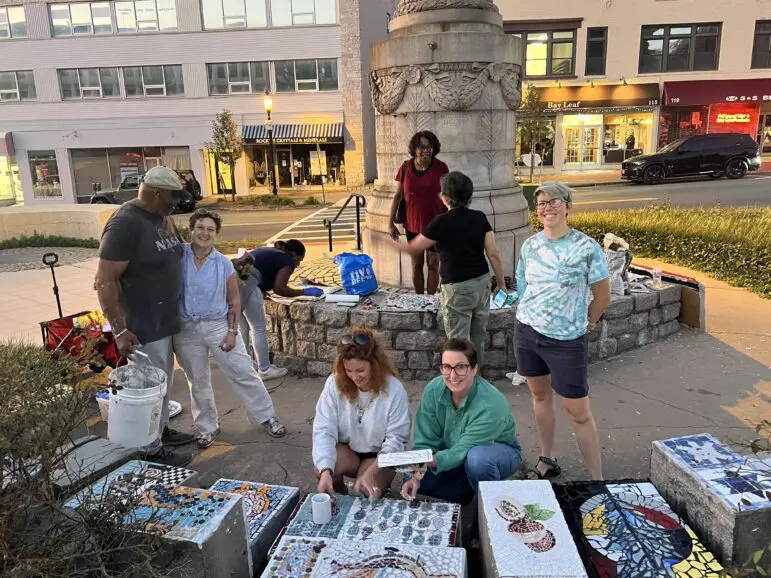
Some of the nearly three dozen participants in the Community Coalition on Race’s Integration through the Arts mosaic public art installation project in downtown South South Orange. (Photo by Marilyn Lehren)
The Integrated Art Circle Program was started by the Coalition’s former program director Audrey Rowe, and funded by the Essex County Parks and Recreational Department, through the New Jersey State Council on the Arts.
“I’m just excited for the near completion of this ambitious mosaic project,” Rowe said. “It embodies the Community Coalition on Race’s Integration through the Arts objective of bringing people of all races and backgrounds together to develop friendships as they create art. The added bonus in this case is that the project also beautifies a South Orange community public space.”
The grant supports Essex County artists, said Coalition Executive Director Nancy Gagnier. “Our program does that in addition to supporting our mission of racial integration by bringing people together in relationship-building experiences. Some of the projects — like Sandra Charlap’s mosaics and Roberta Melzl’s murals — have the added benefit of public installations where people can enjoy the art and learn more about the group experience sponsored by the Community Coalition on Race.”
When Charlap posted the mosaic opportunity on social media, artist Emily Konopinski said she was thrilled to participate and she recruited two fellow artists and friends to join her.
“Sandra is a great bridge in our community. She makes arts accessible for everyone and also keeps in close contact with fellow artists for projects like this where we can all help each other,” said Konopinski, who has been involved with CCR since late ’90s when her mother volunteered with the organization. “My family is multicultural and mixed race and finding a space where other people understand what that is like and have lived experience is so valuable. The CCR is a space where that type of connection thrives.”
Konopinski’s mosaic is part of her Fish is Fish series, named after the children’s picture book by Leo Lioni. “It represents our differences and similarities and the importance of finding those who will love and protect us. It was an honor to create this alongside my neighbors, and I am honored to be a part of the public art in South Orange.”
Charlap’s social post also reached others, some who don’t consider themselves artists but who wanted to create art and be part of a project bringing community together.
Maurice Davis, who has taken other art classes with Charlap and does tiling as part of his work, helped all the participants when it came time to install their mosaics.
“It was a privilege to help and work with Sandra and a team of people to brighten up a special place with some beautiful mosaics that everyone can enjoy,” he said. “Knowing that [the flag pole] is a memorial representing our war hero was such a pleasure for me also.”
Hilary Patterson started attending the mosaic workshop the week after she moved across the country from the Pacific Northwest to Maplewood, where she had lived as a child.
“Seeing all of the mosaics installed together left me with a very grounded sense of interconnectedness and strength during a time of tremendous imbalance,” she said. “Having the opportunity to create art based on a group directive: creating reflections of your culture and/or family, for me highlighted the multicultural brilliance and intergenerational celebration of collective autonomy through visual storytelling. The group installation is like a mosaic quilt.”
“In my piece I reflected on intergenerational healing, resilience eclipsing difficult paths of life’s journey and pride within my Black Indian and African American heritage,” she said. “The Medicine Wheel representation and a Feather representing the South’s Great Migration were aspects of my family’s African American and Native American experience that has eclipsed intense adversity. The mosaic group was such a personal celebration of who we are!”
For more information on the Coalition’s Integration Through the Arts program and Integrated Art Circles, visit the Coalition’s website.
Editor’s Note: Laura Griffin, the author of this story, participated in the mosaics Integrated Art Circle, recreating a self-portrait drawn by her son, Max Goldstein, who grew up in South Orange and died earlier this year.


